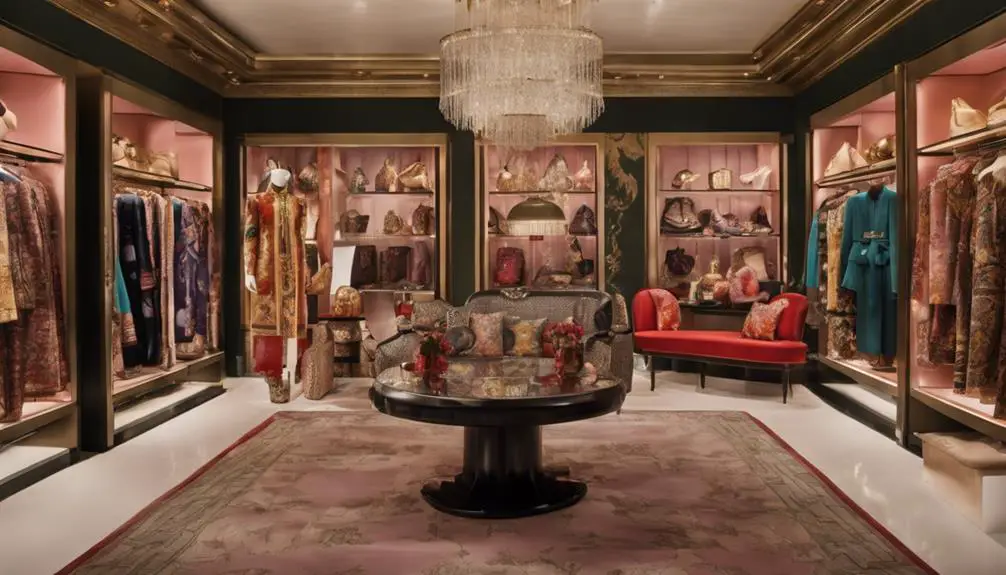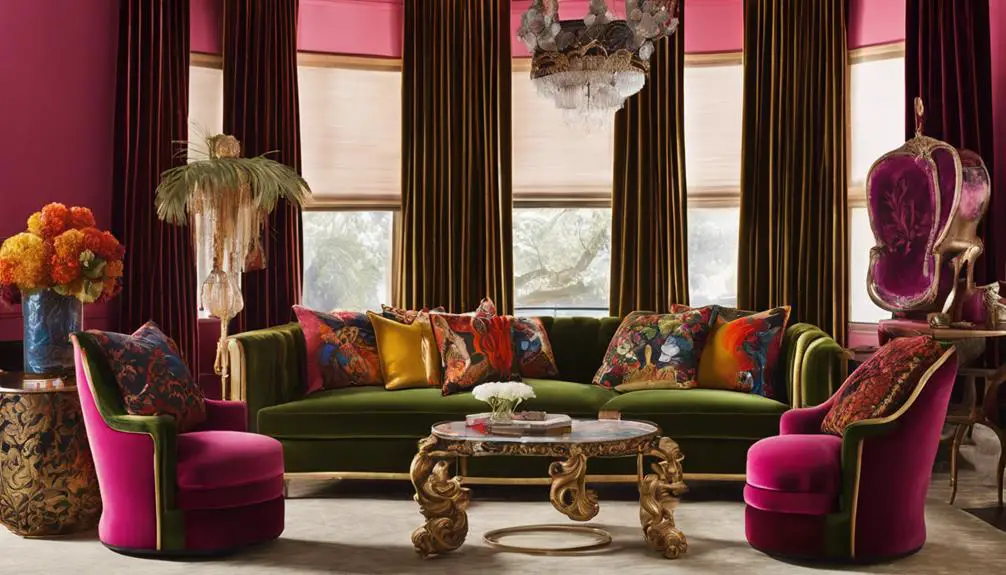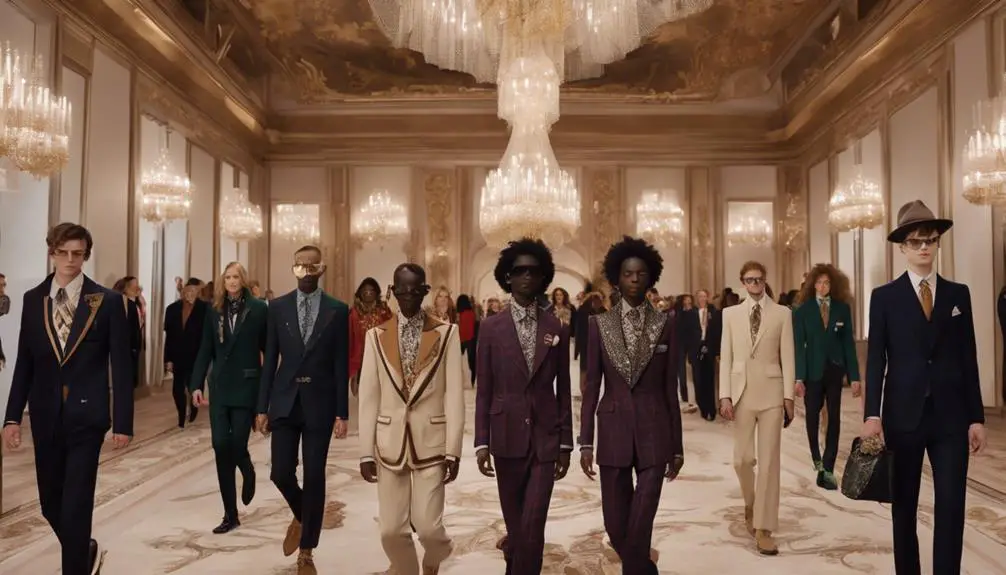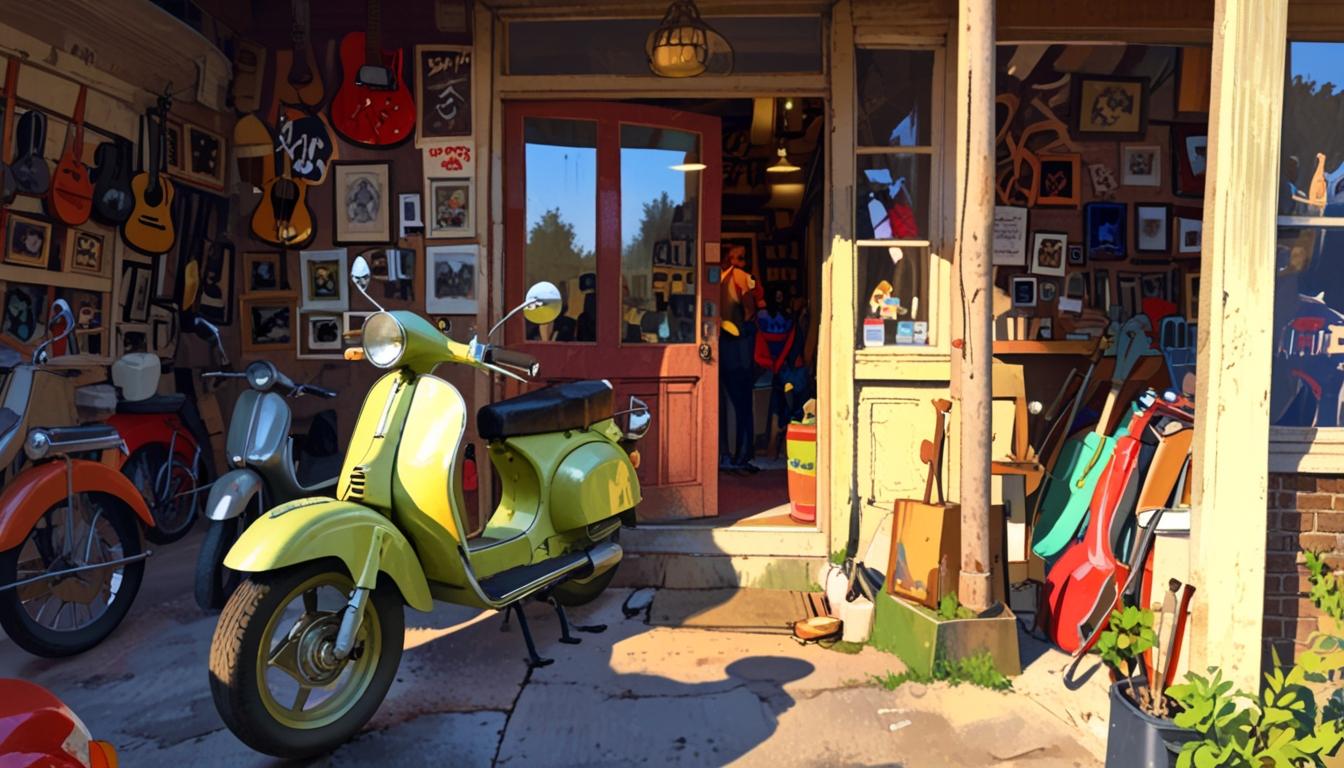Did you know that the House of Gucci has been a significant player in the fashion industry for over 100 years? As you explore the greatest designs that define its legacy, you'll discover a fascinating interplay of styles and influences that reflect both modernity and classic Italian elegance. From iconic set pieces to character-inspired interiors, the depth of Gucci's design philosophy is striking. What elements truly make these designs stand out in the crowded world of fashion?
Overview of House of Gucci

The "House of Gucci" offers a gripping glimpse into the opulent yet troubled world of one of fashion's most iconic families. Directed by Ridley Scott, this enthralling film dives deep into the ambitious life of Patrizia Reggiani and her tumultuous marriage to Maurizio Gucci. As you watch, you'll find yourself drawn into the intricate dynamics of the Gucci family, whose legacy in luxury fashion is both glamorous and fraught with betrayal.
Through the eyes of real-life characters, like the powerful fashion designer Maurizio Gucci, the film explores themes of power, wealth, and the complexities of family ties. You'll see how the once-thriving Gucci family struggled to maintain control over their luxury fashion empire, facing challenges that would test even the strongest bonds. The narrative intertwines dramatic reimaginings of their relationships with actual events, giving you an authentic sense of the highs and lows they experienced.
Lady Gaga's portrayal of Patrizia Reggiani brings an electrifying energy to the film, while Adam Driver's performance as Maurizio adds depth to their tumultuous marriage. As the story unfolds, you can't help but admire the allure of the fashion world, while also grappling with the tragic elements of their legacy. In "House of Gucci," you witness not just the rise and fall of a family but also the compelling story behind one of the most recognized names in fashion history.
Iconic Set Designs
Stepping into the world of *House of Gucci*, you're immediately captivated by the iconic set designs that transport you through time and space. Each meticulously crafted scene reflects the opulence and drama of the Gucci legacy, showcasing the architectural significance of locations like Villa Necchi, the stunning home of Rodolfo Gucci. This 1930s Milanese villa, with its Rationalist lines and historical charm, sets the tone for the luxurious narrative.
As you wander through the lavishly recreated Gucci store in Manhattan, the dark woods and archival handbags evoke a sense of nostalgia, embodying the old-world charm of the era. The set design team didn't stop there; they brought to life Villa Balbiano, Aldo Gucci's home, a late-16th-century mansion nestled on the shores of Lake Como. With baroque frescoes and beautifully landscaped gardens, this location adds layers of elegance to the film.
The film also transports you to the vibrant nights of Studio 54, where the essence of 1970s nightlife comes alive. Here, you'll find luxury automobiles like the Lamborghini Diablo and vintage Mercedes, enhancing the visual allure of high fashion.
Character-Inspired Interiors

Within the *House of Gucci*, character-inspired interiors vividly embody the personalities and lifestyles of the iconic figures they represent. Each space tells a story, reflecting the unique traits of the Guccis. For instance, Rodolfo Gucci's home, modeled after Villa Necchi Campiglio, showcases Rationalist architecture with its elegant lines and historical features, giving you a taste of refined Milanese living. Aldo Gucci's residence at Villa Balbiano, a late-16th-century mansion on the picturesque Lake Como, bursts with baroque frescoes and a rich collection of antiques, revealing his appreciation for opulence.
Meanwhile, Maurizio and Patrizia Gucci's lavish Italian home, inspired by Villa Polisena, symbolizes fashion royalty with its sophisticated design and historical significance. You can almost feel the glamorous soirées held within those walls. Patrizia's New York apartment, reflecting the late 80s and early 90s modern aesthetic, stands out with striking pop art and chrome elements, perfectly capturing the couple's evolving lifestyle in a bustling city.
The film also offers a glimpse into the Gucci family's chalet, seamlessly blending authentic antiques with light woods to create a rustic charm typical of northern Italian chalets. This architectural design pays homage to their heritage while adding warmth and character to the interiors. Each setting not only highlights the lavish lives of the Guccis but also invites you to experience the essence of their world through thoughtfully curated spaces.
Fashion and Costume Highlights
Fashion plays a pivotal role in *House of Gucci*, showcasing the vibrant styles that defined an era and the characters' journeys. The film's stunning costumes, crafted by Oscar-winning costume designer Janty Yates, immerse you in the world of 1970s and 1980s Italian fashion. Yates conducted extensive research, visiting the Gucci museum and vintage archives to guarantee every piece was authentic and resonated with the film's themes.
You'll see how Lady Gaga's portrayal of Patrizia Reggiani features a remarkable wardrobe evolution, highlighting her rise within the Gucci family. Her striking pink and black polka dot Yves Saint Laurent dress pays homage to the iconic imagery of the '60s bombshell Gina Lollobrigida. In contrast, the film also features key menswear looks, like Paolo Gucci's flamboyant pink jumbo cord suit and Maurizio Gucci's casual ski attire, each reflecting their distinct character personalities and fashion choices.
The costumes not only illustrate power dynamics and social status but also emphasize how Patrizia's bold, extravagant outfits juxtapose Maurizio's more understated looks. This visual storytelling brilliantly captures their differing roles within the family. The influence of these designs extends beyond the screen, sparking significant cultural discussions, igniting social media trends, and inspiring Halloween costume choices. Overall, the fashion and costume highlights in *House of Gucci* serve as a vivid historical reference, celebrating the enthralling essence of Gucci's legacy and its impact on fashion history.
Timeless Design Elements

The lavish designs of the House of Gucci extend beyond the domain of costume, embracing a unique aesthetic that captures the essence of Italian luxury. Timeless elegance finds its way into every corner of Gucci's creations, where the interplay of ultra-modern styles and classic elements creates a sophisticated ambiance that resonates with high fashion. You'll notice how mirrored chrome and bold prints bring a vibrant energy to the space, embodying both luxury and Italian aesthetics.
Key furniture pieces, like the Platner armchair and Eames plastic shell chair, enhance the overall design, contributing to that unique and glamorous look that Gucci is known for. Each element serves a purpose, inviting you to experience comfort while appreciating the artistry behind the choices. The production design spans iconic locations, showcasing interiors that evoke the very heart of Italian style, making every setting feel like a work of art.
Color and texture play essential roles in the House of Gucci's legacy, crafting an atmosphere of warmth that captivates the senses. The careful selection of hues not only adds visual impact but also enhances the feeling of sophistication and elegance. When you step into a space influenced by Gucci's timeless design elements, you're not just observing a room; you're immersing yourself in a narrative woven from decades of creativity, culture, and an unyielding commitment to excellence. It's this blend of innovation and tradition that keeps the House of Gucci at the forefront of design.



